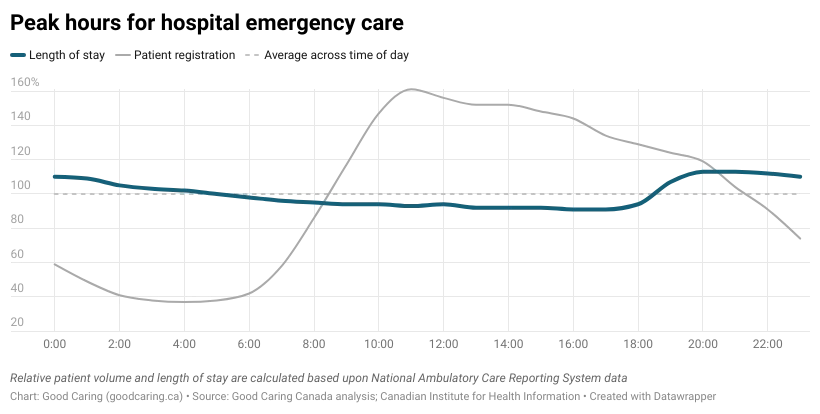Emergency room (ER) wait times can be long at Dawson City Community Hospital. Long ER wait times can delay critical care, reduce patient satisfaction, and increase the risk of complications.
Most patients wait no more than 1.2 hours for the initial physician assessment in the emergency department. Most patients stay for no more than 24.1 hours in total duration.
Dawson City Community Hospital may face prolonged wait times as it serves a remote population with limited resources and increasing demand for emergency care.
Dawson City Community Hospital serves Dawson City and surrounding rural areas, including a significant Indigenous population. Common health concerns include managing chronic diseases, access to mental health and addiction services, and addressing healthcare delivery challenges in remote locations. Seasonal variations in the population due to tourism and mining activities can also impact healthcare needs.
If wait times are too long at Dawson City Community Hospital, consider visiting Whitehorse General Hospital, approximately 530 kilometers away.
Plan for Peak Times
Planning your visit to the emergency department at Dawson City Community Hospital can significantly impact wait times, particularly if the medical issue is not urgent.

Mondays tend to be the busiest day of the week in most emergency departments. The accumulation of non-emergency cases over the weekend often result in a surge of patient volume on the first work day of the week.
If your condition allows for flexibility in seeking care, consider the day of the week for your visit. Avoid Mondays and weekends.

The time of day is unlikely to significantly reduce wait times, as hospitals align staff availability with patient volumes.
During standard business hours, from morning to early evening, full staffing is in place. However, higher patient volumes during these times can create bottlenecks. Even with more medical personnel, increased demand can still lead to longer waits as emergency departments handle the influx of patients.
Late-night and early-morning hours may seem ideal due to fewer patients. However, reduced staffing during these hours often negates the benefit of a smaller patient load. Patients may still face long waits due to limited healthcare providers.

Demand seasonality can affect wait times in emergency departments across Canada, particularly among younger patients. Young children, aged 0 to 5, see a rise in emergency visits during autumn, with a notable decline in the summer months. Children, aged 5 to 19, experience a peak in spring and a similar decrease in the summer.
Adults, aged 20 to 64, generally show consistent demand for emergency care throughout the year. Seniors over 65 also follow a steady pattern, with minimal seasonal fluctuations.
Bring a Comfort Kit
Before heading to Dawson City Community Hospital, pack a comfort kit with items to help pass the time and reduce stress. Include entertainment such as a book, magazine, or e-reader, and download shows, audiobooks, or music onto your phone or tablet. Noise-canceling headphones or earbuds can help block out the chaotic sounds of a busy waiting room, providing a sense of calm. Make sure your phone is fully charged, and bring a portable charger to ensure you can stay connected throughout your visit.
Snacks and a water bottle are also essential. While vending machines or cafeterias may be available, having non-perishable items like granola bars, trail mix, or crackers ensures you don’t need to leave the waiting area to eat. Staying hydrated is important, so pack a reusable water bottle, especially if access to drinking water is limited. Wear comfortable, layered clothing, as emergency rooms often fluctuate in temperature. Bringing a light sweater, blanket, or neck pillow can add to your comfort during extended waits.
Be Comfortable in the Waiting Room
Once at Dawson City Community Hospital, focus on making your personal space as comfortable as possible. A small pillow or portable blanket can help during long hours of sitting. Engage in mindfulness activities, such as deep breathing exercises, guided meditations through apps like Calm or Headspace, or journaling. These techniques can help reduce anxiety and provide mental clarity, especially in the uncertain environment of an emergency room.
Low-energy, engaging activities can also help pass the time productively. Portable crafts like knitting or crocheting, adult coloring books, or small games can provide distraction and relaxation. If you prefer digital entertainment, mobile games or podcasts are excellent options. Keeping busy can help shift your focus away from the wait and create a sense of normalcy.
Stay Clean and Organized
Maintaining cleanliness and organization in the waiting room at Dawson City Community Hospital can contribute to peace of mind.
Use disinfectant wipes or hand sanitizer to clean surfaces like armrests, tables, or chairs. Avoid placing personal items like bags or phones on shared surfaces to reduce exposure to germs. Keeping your belongings organized and sanitized helps create a sense of control in an otherwise unpredictable situation.
Be Patient & Emotionally Prepared
Prepare yourself emotionally for the realities of visiting Dawson City Community Hospital. Emergency rooms prioritize the most critical cases first, so wait times can vary greatly. Practicing patience and empathy—for yourself, medical staff, and other patients—can ease the emotional strain. Remember that healthcare workers are doing their best in a high-pressure environment to provide timely care to everyone.
Perpetuate Positive Change
You can play an important role in supporting the emergency department in Dawson City Community Hospital and beyond. By making informed decisions and taking proactive steps, you can reduce help to reduce emergency wait times, while fostering a more positive healthcare experience for all.
- Choose the Right Level of Care. Many non-urgent conditions can be treated outside Dawson City Community Hospital. By utilizing family doctors, walk-in clinics, urgent care centers, and pharmacists for minor health issues, Ontarians can help reserve emergency resources for those in critical need. Understanding when and where to seek care is a simple yet impactful way to alleviate overcrowding.
- Embrace Preventive Health Measures. Preventive care is a cornerstone of reducing the burden on hospitals. Staying up to date on vaccinations, including flu shots, can help prevent illnesses that often result in visits to Dawson City Community Hospital. Additionally, maintaining regular check-ups with primary care providers can catch potential health issues early, preventing them from escalating into emergencies.
- Practice Patience and Empathy. Dawson City Community Hospital operate on a triage system, prioritizing the most critical cases. When visiting the emergency department, understanding this process and being patient can make a difference. Treating healthcare workers and fellow patients with kindness fosters a more supportive and positive environment.
- Support Healthcare Workers. Healthcare workers at Dawson City Community Hospital face immense pressure, particularly during peak times or public health crises. Supporting them by showing appreciation, volunteering for healthcare initiatives, or simply following public health guidelines (like masking and hand hygiene during outbreaks) can make their jobs easier.
Options for Non-Urgent Conditions
If medical conditions are not urgent, patients can consider alternative options to the emergency department at Dawson City Community Hospital:
- Family doctors serve as the primary point of contact for managing ongoing or non-urgent medical concerns. They provide comprehensive and personalized care, often maintaining detailed records of a patient’s medical history, which facilitates continuity of care and long-term management of health conditions.
- Walk-in clinics offer convenient medical services for minor injuries or illnesses without the requirement of an appointment.
- Urgent care centres provide medical attention for non-life-threatening conditions, such as minor fractures or severe flu symptoms. These centres typically offer faster service compared to emergency departments.
- Nurse practitioner-led clinics can provide primary care services for non-emergency health needs. These clinics are particularly valuable if family doctors are not available in the area.







